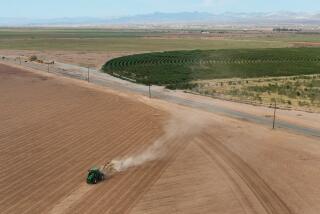Odds of a weak El Niño are still good, but forecasters say it’s not here yet
- Share via
For months, El Niño conditions have been brewing in the tropical Pacific. But the climate pattern still hasn’t clicked into place, forecasters said Thursday.
Surface waters in the eastern part of the Pacific basin have warmed, as they would during a full-blown El Niño. But circulation patterns in the atmosphere have not shifted as expected, according to a monthly update issued by the National Oceanic and Atmospheric Administration’s Climate Prediction Center and the International Research Institute for Climate and Society at Columbia University.
That means Californians will have to keep waiting to see what kind of weather the winter brings.
El Niño can increase the odds of a wetter year in Southern California, said Nina Oakley, regional climatologist at the Western Regional Climate Center. She said, however, it’s not guaranteed, and “the relationship is a little more tenuous as you get into the northern two-thirds of the state.”
Part of the reason an El Niño hasn’t formed yet is that another climate phenomenon — known as the Madden-Julian Oscillation — is currently in an opposing phase, said Tony Barnston, chief forecaster at IRI.
The MJO can be thought of as a cluster of thunderstorms that migrates across the tropics. Right now, it’s centered over the western part of the Pacific, near Indonesia, where it counteracts the atmospheric circulation pattern that normally establishes during El Niño.
But as the MJO moves eastward over the coming month, it should promote El Niño formation, Barnston said.
Forecasting models suggest it’s still likely that El Niño will take shape later this winter. Thursday’s report puts the odds at 65% — down from 90% in December.
By the time El Niño does arrive, it probably won’t bring huge changes to weather patterns, the forecasters wrote in the report: “Given the timing and that a weak event is favored, significant global impacts are not anticipated during the remainder of winter, even if conditions were to form.”
For Southern California, that means the chances of increased rainfall are not as good as they would be during a stronger and longer-lived El Niño, Barnston said. But the region could still see higher-than-normal precipitation later in the winter and spring.
NOAA’s seasonal outlook for the next three months, also released on Thursday, suggests greater odds of above-average rainfall in the state’s southeastern deserts, below-average precipitation in the northwest corner of the state, and an equal chance of either — or neither — for the areas in between.
In reality, it’s been a dry season for much of California so far.
“There have been several recent storms, which is great,” Oakley said. “But despite the recent precipitation, much of California is still reporting below-normal water years since Oct. 1.”
That’s important information for managing water supplies. But Oakley stresses that the total precipitation outlook does not directly affect the likelihood of hazards like post-wildfire landslides, which can be triggered by a single pulse of precipitation.
“All it takes is that one storm with high-intensity rainfall in it,” she said.
Thursday’s forecast came out despite the partial government shutdown and was not significantly affected by it, Barnston said. Most forecasters are considered essential staff, he said, and the models they rely on run automatically.
Forecasters, however, did have to make adjustments because some of the data they normally used were not available for December.
A network of NOAA-operated buoys in the tropical Pacific that measure ocean and air temperatures and wind speed did not update, Barnston said. It’s unclear why; the scientist in charge of the project was furloughed and could not be reached.
Researchers also had to make do without another data set of sea surface temperatures. Luckily, they had access to different measurements, which they could use instead.
“It’s like a mechanic who’s missing a few tools in the tool chest,” Barnston said. “There are other tools that can do the same thing. It might have taken five to 10 minutes longer, which is not a big deal.”
The most notable effect of the shutdown was on the Climate Prediction Center’s activities. Government forecasters can’t speak with the public or elaborate on the new report online because the Climate.gov website is currently unavailable.
From the edge of Earth to the frontier of the solar system, 9 science stories for 2019 »







